[DG][CLS] SWAD: Domain Generalization by Seeking Flat Minima
[DG][CLS] SWAD: Domain Generalization by Seeking Flat Minima
- paper : https://arxiv.org/abs/2102.08604
- github : https://github.com/khanrc/swad
- NeurIPS 2021 (인용수 148회 , ‘23.07.09 기준)
- task : Domain Generalization for Classification
Abstract
- 문제제기: 기존의 ERM (Empirical Risk Minimization)으로 non-convex loss funtion의 sharp minima로 수렴시키는 학습기법은 generalizability를 해친다.
- 제안점 : loss function의 flat minima를 찾는 것이 domain generalization gap을 줄이는 것임을 이론적으로 보임
- SWAD (Stochastic Weight Averaging Densely)를 제안하여 기존의 SWA 보다 flatten minima에 수렴함을 보임. (+ less overfitting)
- 차별점 : dense하게 average를 하되, overfit-aware하게 stochastic weight sampling 전략을 취함
- DG for classification Dataset 5개에서 SOTA를 찍음
1. Introduction
- 기존 연구의 한계점
- ERM으로 학습함 → Sharp minima에 빠지면 i.i.d. 상황이 아닌 DG상황에서는 domain shift로 인해 loss curve가 달라지므로 generalizability가 훼손됨
- flat minima가 generalizability를 향상시킨다는 연구들도 모두 i.i.d.상황을 가정함 → DG상황은 generalizable gap이 flat minima와 sharp minima가 크게됨
- 제안점
- flat minima가 unseen domain에서 더 generalizable함을 보이기 위해 RRM (Robust Risk Minimization)을 정의함
- RRM: neighbor parameter space 상에서 worst-case empirical risk임
- generalization gap of DG의 Upper bound
- RRM: neighbor parameter space 상에서 worst-case empirical risk임
- SWAD : 기존에 flat minima를 잘 해결하는 SWA (Stochastic Weight Averaging)에서 두 가지를 변형함
- densly : epoch based에서 iter based로 weight averaging
- overfit-aware averaging : validation loss를 기준으로 overfit을 방지하도록 averaging
- flat minima가 unseen domain에서 더 generalizable함을 보이기 위해 RRM (Robust Risk Minimization)을 정의함
2. Theoretical Relationship b/w Flatness and DG
-
Loss의 최적 해는 여러가지 있을 수 있음
-
근데 기존 방법 (ERM)은 sharp minima로 수렴할 수 있음

- n : source domain별 이미지 갯수
- I : source domain 갯수
-
worst-case neighbor parameter space로 RRM (Robust Risk Minimization) 정의

-
$\gamma$: neightborhood of $\theta$를 정의하는 radius
-
가령, sharp minima인 경우, “radius”가 $\gamma$보다 작게 되면 RRM이 커지므로, minima가 아니게됨
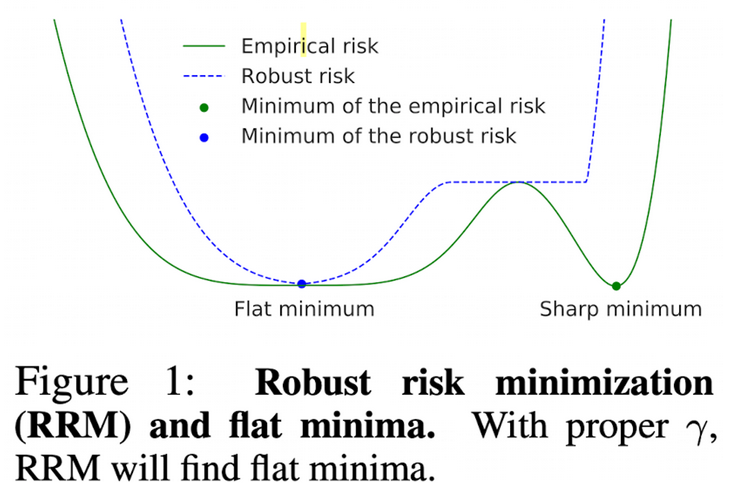
-
-
Target domain Risk 와 ERM의 관계

- 1째항 : Source domain에서의 RRM
- 2째항 : Target domain과 Source domain 분포의 간극
- 3째항 : gamma와 sample 갯수에 연관된 confidence bound
- delta : (표준확률정규분포 같은 느낌) 95% 확률과 오차분포로 정확하다 이런 의미인듯.
- diam : minima랑 neightbor minima 간의 간극 중 가장 큰 것 (diameter)
- vk : VC dimension (파라미터의 학습 가능한 volume. Vapnik–Chervonenkis dimension)
-
Generalization gap := RRM - ERM으로 정의

- 1째항 : Source domain에서 RRM - ERM
- 2째항 : Target domain과 Source domain 분포의 간극
- 3째항 : Confidence bound
3. SWAD: Domain Generalization by Seeking Flat Minima
-
Baseline : SWA
- K epoch마다 weight를 모아서 update → Too sparse!
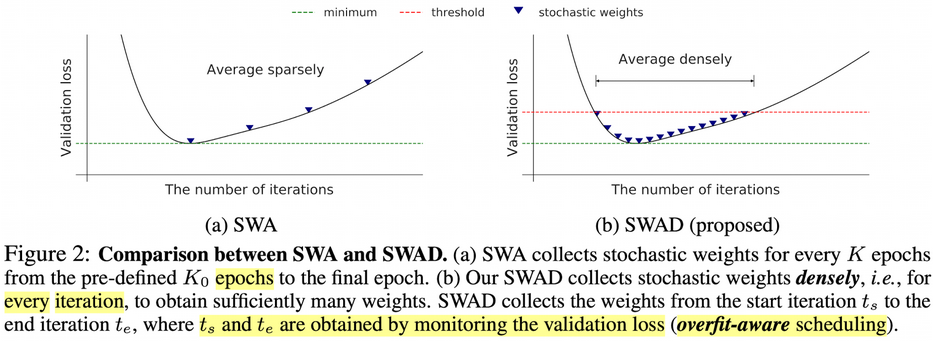
-
SWAD
-
iteration마다 weight를 모아서 update → Dense!
-
Validation loss를 기준으로 start, end구간 정의
-
start ($t_s)$

-
end($t_e)$

- r : tolerance rate
-
-
-
Local Flatness
- RRM - ERM 대신 E(ERM) - ERM으로 정의 → RRM - ERM 정의하면 biased되어 있기 때문
- MC Sampling을 100번 수행해서 $\theta’$을 구함
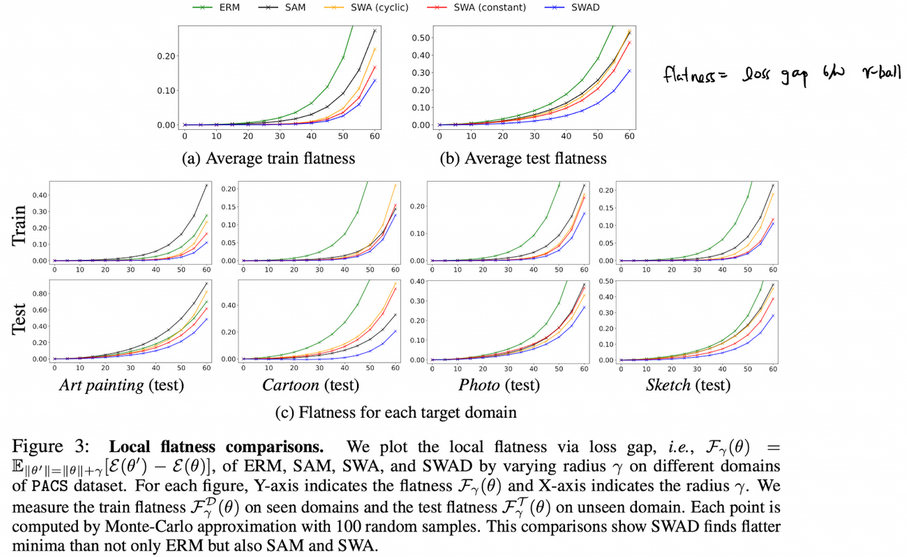

-
Local Surface Visualization
- ERM은 Train Loss의 flat loss 변두리에 위치하지만, SWAD는 Train/Test loss의 중간에 위치 (평균)
- 각 점은 2.5K, 3.5K, 4.5K step의 weight가 계산한 loss
- x axis : $\theta_2 - \theta_1$
-
y axis : $\frac{(\theta_3-\theta_1)-<\theta_3-\theta_1, \theta_2-\theta_1>}{ \theta_2-\theta_1 ^2 (\theta_2-\theta_1)}$ - value : loss 값
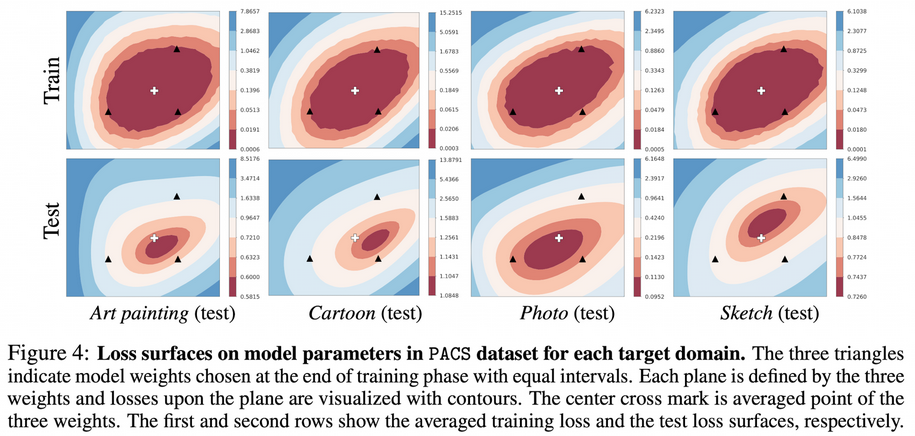
- ERM은 모델 선택에 따른 accuracy가 요동치지만, SWAD는 overfit-aware scehudling으로 모델 selection-free

- ERM은 Train Loss의 flat loss 변두리에 위치하지만, SWAD는 Train/Test loss의 중간에 위치 (평균)
4. Experiments
Dataset
- PACS (9,991 images, 7 classes, 4 domains)
- VLCS (10,729 images, 5 classes, 4 domains)
- OfficeHome (15,588 images, 65 classes, 4 domains)
- TerraIncognita (24,788 images, 10 classes, 4 domains)
- DomainNet ( 586,575 images, 345 classes, 6 domains)
Results
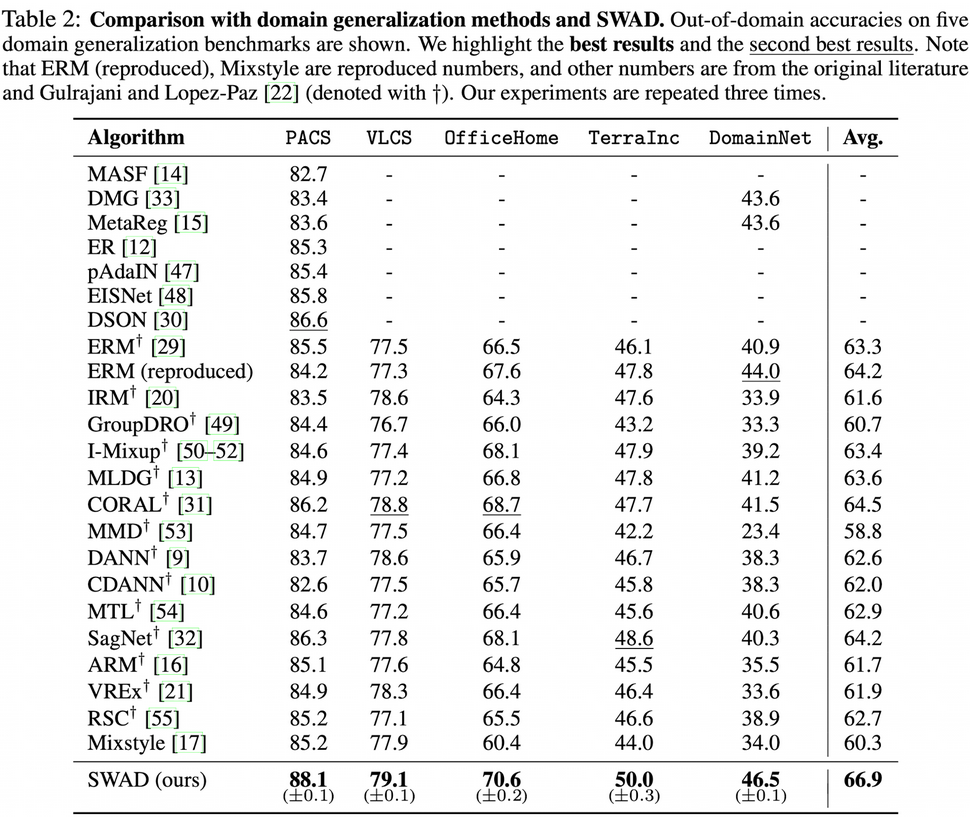
-
Orthogonality
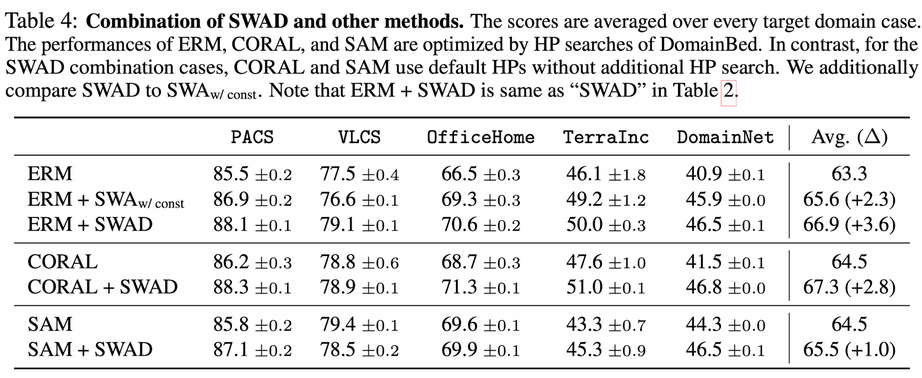
- 기존 SOTA에 SWAD를 추가하면 모두 상승함
-
In-domain / Out-of-domain

- 기존 다른 DG방법들은 ID에서는 잘되나, OOD에서는 잘 안됨 (SWA, SWAD 제외)
Ablation study
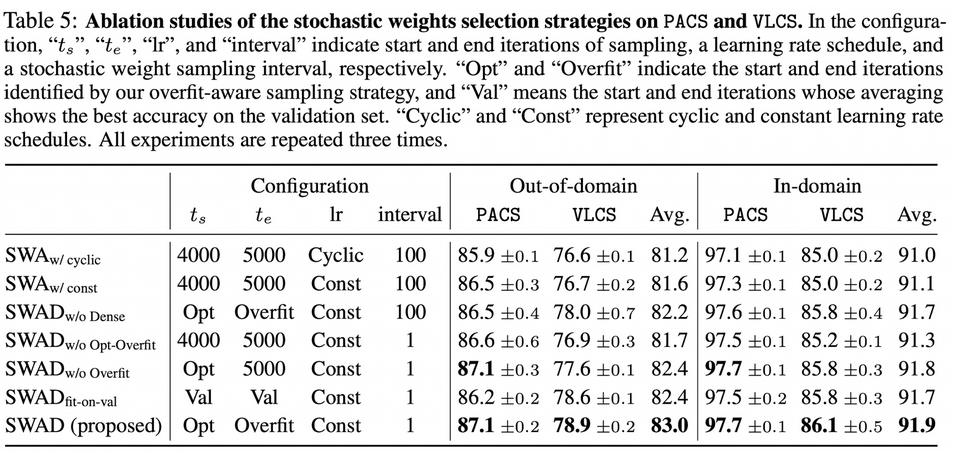
Imagenet Robustness

- BGC : bg/fg 영역을 수정해도 모델이 consistent한 값을 예측하는지 확인 (robustness)
- ImageNet-C (mCE) : mean corruption Error. Gaussian Blur, 등 corruption에 따른 error가 적은지 체크 (robustness)
- ImageNet-R : accuracy. (DG)
5. Conclusion
- DG는 Flat minima를 찾음으로써 실현 가능하다.
- Flat minima를 찾는 것이 DG를 푸는 것임을 이론적/실험적으로 증명했다.
- Mixup, Cutmix등 기존 augmentation기법은 OOD (DG)의 성능을 해친다.
